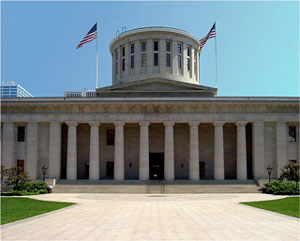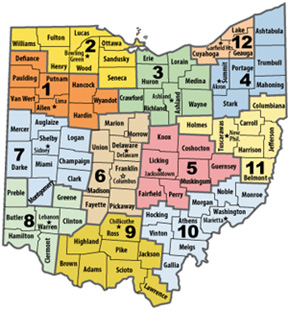OHIO DEPARTMENT OF TRANSPORTATION
SHPO Liaison Program
Program Description

Ohio Statehouse, Columbus, Ohio.
(Source: Wikimedia Commons, Alexander Smith, 2004.)
Program Benefits
- ODOT has also been able to reach “no adverse effect” findings based on early consultation with the State Historic Preservation Office’s (SHPO) designated ODOT reviewers.
- As a result of this liaison program, the process of achieving concurrence on Section 106 findings has been streamlined.
- There is a positive working relationship between ODOT and SHPO, resulting from the liaison program.
The Ohio Department of Transportation’s (ODOT) revised Section 106 Programmatic Agreement, executed November 30, 2011, stipulates the funding of two positions at the Ohio State Historic Preservation Office (SHPO), to ensure the implementation of Section 106 in accordance with the agreement and to streamline the consultation process. This agreement builds upon two previous delegation agreements. The positions funded by ODOT (i.e., ODOT Transportation Review Managers) are dedicated to the review and processing of ODOT projects.
ODOT’s funding of these positions has resulted in a collaborative Section 106 consultation process. Consultation includes informal and formal methods such as joint early project field scoping meetings with ODOT Cultural Resources (CR) staff, ODOT District Environmental staff, and the SHPO; in addition to informal meetings with CR team members and SHPO regarding survey methods, historic boundaries, National Register eligibility, identification of consulting parties, and measures to minimize harm to historic properties.
The SHPO’s ODOT Transportation Review Managers recently assisted Federal Highway Administration (FHWA) and ODOT in the preparation of ODOT’s updated Section 106 Training Class. ODOT district staff and ODOT’s consultants attend this and other classes as a part of ODOT’s professional certification program. The training team participates in a follow-up meeting after each training class to discuss ways to improve the next class. This approach has enhanced the working relationship between the agencies while recognizing their respective roles and responsibilities.
Setting Up the Program
Program Elements
- Historic Preservation in Early Project Development
- Interagency Cooperation and Collaboration
ODOT first contracted for the review positions at the SHPO in 1998. At that time, ODOT had a large highway program with several rural four-lane gap closure projects around the State, so there was a large volume of projects requiring reviews by ODOT and SHP0 staff. Though ODOT had the largest and most complicated projects going to SHPO for Section 106 review, ODOT was actually third in quantity behind Housing and Urban Development and U.S. Army Corps of Engineers projects. ODOT’s executive management called a meeting of ODOT, SHPO, and the FHWA, stating that it was time to become more collaborative and proactive in terms of Section 106 reviews. For ODOT to effectively advance its highway program, the Department could not wait weeks or months for the SHPO to complete its Section 106 reviews. It became clear that the only way to advance the program was to fund dedicated review positions at the SHPO. ODOT and the SHPO then held a number of meetings on this issue and developed the State’s first agency position-funding contract. It was presented to the Ohio State Controlling Board for review. ODOT and SHPO management articulated to the Board the need, the cost/benefit, goals, and the projected results of the contract, which was for two years. The Board approved this first contract, and has approved all subsequent two-year contracts.
Challenges Encountered
The biggest challenges were legal and contractual. There were no models in 1998 on how to set up this type of program. To implement such a program, it was necessary to address questions such as: What type of contract should be prepared? How is performance to be monitored? How is funding handled for the purposes of interagency billing? ODOT’s environmental office worked closely with ODOT legal staff, the Office of Contracts, the SHPO’s counsel, and others to address these and related issues. There also was an initial uncertainty as to how the State Controlling Board would view this arrangement between ODOT and the SHPO, especially since the SHPO is housed within the Ohio Historical Society, which is a quasi-private/public entity.
Program Maintenance

Map of Ohio Counties by ODOT Districts.
(Source: Ohio Department of Transportation.)
ODOT still funds the two designated SHPO review positions in the same manner. The revised Section 106 Programmatic Agreement (executed in November 2011) specifies that ODOT will enter into an agreement with the SHPO every two years to fund up to two review positions at the SHPO.
No major challenges have been encountered with the staff liaison program. The working relationship ODOT has established with the SHPO, FHWA, and the ODOT district offices has allowed resolution of any unexpected challenges.
Currently, the SHPO review positions have not been affected by the downturn in the economy or tightening of state budgets.
Critical Factors for a Successful Program
There are four critical points that make the program a success:
- Consult with the SHPO reviewers early and often as part of the project development process.
- Keep the project managers and district contacts informed on any questions the SHPO reviewers may have throughout the process.
- Conduct regular team meetings with the SHPO reviewers. This ongoing communication has served as tool to work through concerns or make refinements to the existing processes.
- The implementation of the Section 106 PA allows SHPO reviewers time to assist the DOT on more complex project issues.
June 1, 2012

